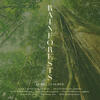Rainforests (2023)
Bill Cunliffe
I. Black River
II. Midnight Island
III. Batucada
The COVID time was a really hard one for me, with much personal stress in my life for many reasons, and although I was able to continue to teach and arrange music with much of my normal efficiency, I was fairly tapped out creatively. But nothing rejuvenates a composer more than an imposing deadline, and it was Terell Stafford and Dean Robert Stroker of Temple University who furnished this for me.
For years, I’ve been intrigued by trees. Not only the trees in my neighborhood of Studio City, California, but the trees that keep us safe and healthy such as the tropical mangrove. Its tangle of roots allows the trees to handle the daily rise and fall of tides and slow the movement of tidal waters, causing sediments to build up the muddy bottom.
Mangrove forests stabilize the coastline, reducing erosion from storm surges, currents, waves and tides. The intricate root system makes these forests attractive to fish and other organisms seeking food and shelter from predators.
The mangroves in the rainforests are truly the heart of our planet and help keep us alive. I’ve been thinking about them a lot, and the music of the tropics has always been a focus of mine, with the recordings I’ve done of Brazilian and Cuban music, samba and salsa.
Rather than ruminate for periods of time over the musical material, the imposed deadline forced me to accept the material immediately offered to me… the strange little child-like melodies that often occur to me after dreams, when I wake up. Rather than cast them aside, this time I wrote them down and, accepting the theory of my former teacher at Eastman, Bill Dobbins, that there is “no such thing as a bad idea,” started work on carving these stones into sculptures of music I could be proud of.
Having three great horn soloists (Terell Stafford, Dick Oatts and Tim Warfield), a great piano soloist (Bruce Barth) and a fabulous symphony orchestra directed by José Luis Domínguez, one of our great conductors, meant I couldn’t go wrong.
The first movement starts with a large battery of percussion playing rainforest-like sounds in the style of a samba, the national dance of Brazil seen all year long, but especially during Mardi Gras, in the streets and barrios. The simple four-note melody is presented and twisted and turned by Tim Warfield in a variety of ways.
Movement two is a cross between a Mexican bolero and a Brazilian bossa, cast as a slow romantic movement. The great Dick Oatts presents the theme as a series of descending thirds, then improvises for a while. The movement ends with a cadenza featuring rainforest sounds as before, with the soloists adding bird calls and other exotic sounds.
Finally, the energetic street dance, but with added movements into meters of 5, 6 and 7, is stated by Terell Stafford and echoed by the orchestra. Hints of jazz big band figures lead into complex rhythmic figures you could get lost in like the rainforest!
A transitional passage built on a Brazilian drum rhythm leads into the final climax, a batucada-like street dance as I saw in Rio so many years ago but overlaid with jazz soloists and dissonant harmonies.
Program note by Bill Cunliffe.

